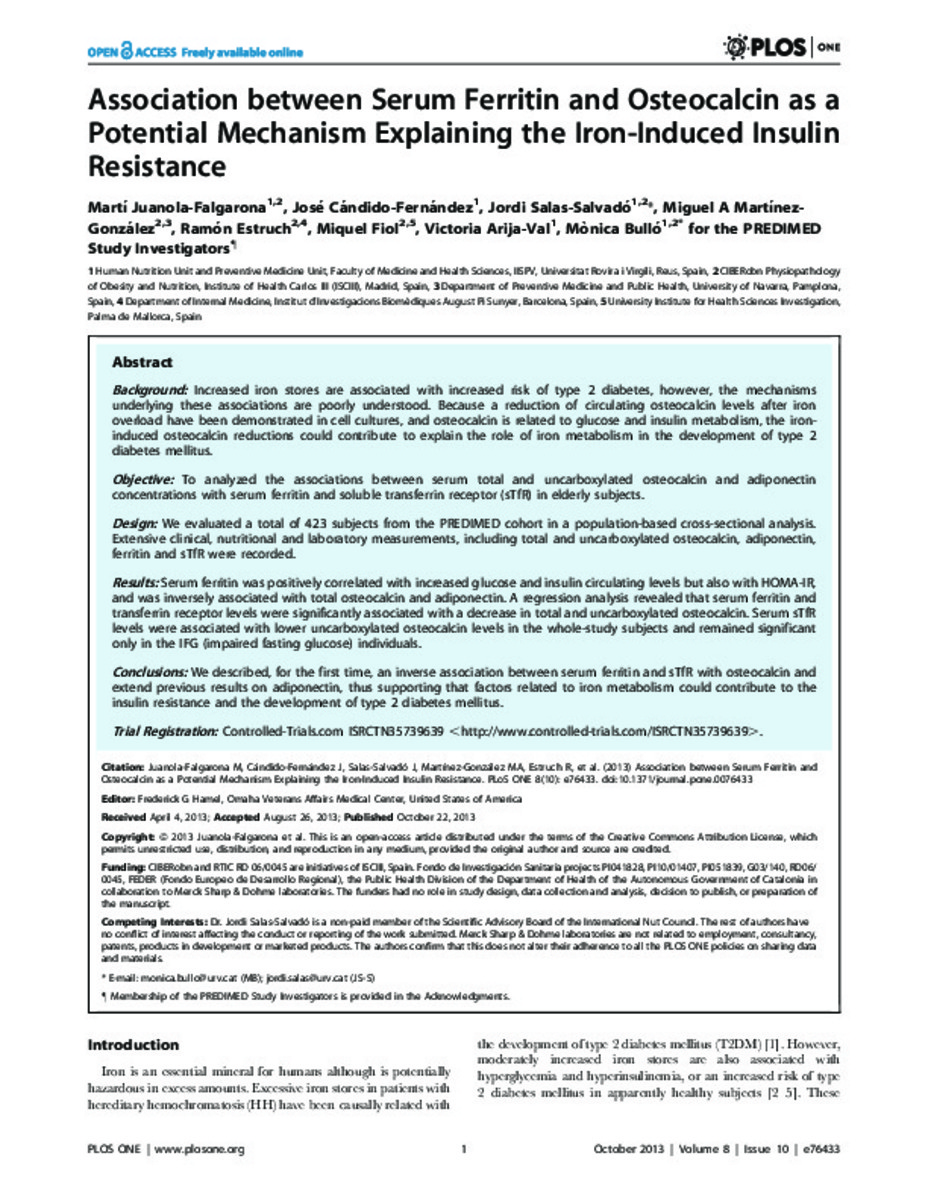Full metadata record
| DC Field | Value | Language |
|---|---|---|
| dc.creator | Juanola-Falgarona, M. (Martí) | - |
| dc.creator | Fernandez-Cao, J.C. (José Cándido) | - |
| dc.creator | Salas-Salvado, J. (Jordi) | - |
| dc.creator | Martinez-Gonzalez, M.A. (Miguel Ángel) | - |
| dc.creator | Estruch, R. (Ramón) | - |
| dc.creator | Fiol, M. (Miquel) | - |
| dc.creator | Arija, V. (Victoria) | - |
| dc.creator | Bullo, M. (Monica) | - |
| dc.date.accessioned | 2014-11-15T19:10:56Z | - |
| dc.date.available | 2014-11-15T19:10:56Z | - |
| dc.date.issued | 2013 | - |
| dc.identifier.citation | Juanola-Falgarona M, Cándido-Fernández J, Salas-Salvadó J, Martínez-González MA, Estruch R, Fiol M, et al. Association between serum ferritin and osteocalcin as a potential mechanism explaining the iron-induced insulin resistance. PLoS One. 2013 Oct 22;8(10):e76433 | es_ES |
| dc.identifier.issn | 1932-6203 | - |
| dc.identifier.uri | https://hdl.handle.net/10171/37050 | - |
| dc.description.abstract | Background: Increased iron stores are associated with increased risk of type 2 diabetes, however, the mechanisms underlying these associations are poorly understood. Because a reduction of circulating osteocalcin levels after iron overload have been demonstrated in cell cultures, and osteocalcin is related to glucose and insulin metabolism, the ironinduced osteocalcin reductions could contribute to explain the role of iron metabolism in the development of type 2 diabetes mellitus. Objective: To analyzed the associations between serum total and uncarboxylated osteocalcin and adiponectin concentrations with serum ferritin and soluble transferrin receptor (sTfR) in elderly subjects. Design: We evaluated a total of 423 subjects from the PREDIMED cohort in a population-based cross-sectional analysis. Extensive clinical, nutritional and laboratory measurements, including total and uncarboxylated osteocalcin, adiponectin, ferritin and sTfR were recorded. Results: Serum ferritin was positively correlated with increased glucose and insulin circulating levels but also with HOMA-IR, and was inversely associated with total osteocalcin and adiponectin. A regression analysis revealed that serum ferritin and transferrin receptor levels were significantly associated with a decrease in total and uncarboxylated osteocalcin. Serum sTfR levels were associated with lower uncarboxylated osteocalcin levels in the whole-study subjects and remained significant only in the IFG (impaired fasting glucose) individuals. Conclusions: We described, for the first time, an inverse association between serum ferritin and sTfR with osteocalcin and extend previous results on adiponectin, thus supporting that factors related to iron metabolism could contribute to the insulin resistance and the development of type 2 diabetes mellitus. Trial Registration: Controlled-Trials.com ISRCTN35739639 ,http://www.controlled-trials.com/ISRCTN35739639.. | es_ES |
| dc.language.iso | eng | es_ES |
| dc.publisher | Public Library of Science | es_ES |
| dc.rights | info:eu-repo/semantics/openAccess | es_ES |
| dc.subject | Insulin resistance | es_ES |
| dc.subject | Serum ferritin | es_ES |
| dc.subject | Diabetes mellitus | es_ES |
| dc.title | Association between serum ferritin and osteocalcin as a potential mechanism explaining the iron-induced insulin resistance | es_ES |
| dc.type | info:eu-repo/semantics/article | es_ES |
| dc.identifier.doi | http://dx.doi.org/10.1371/journal.pone.0076433 | es_ES |
Files in This Item:
Statistics and impact
Items in Dadun are protected by copyright, with all rights reserved, unless otherwise indicated.






